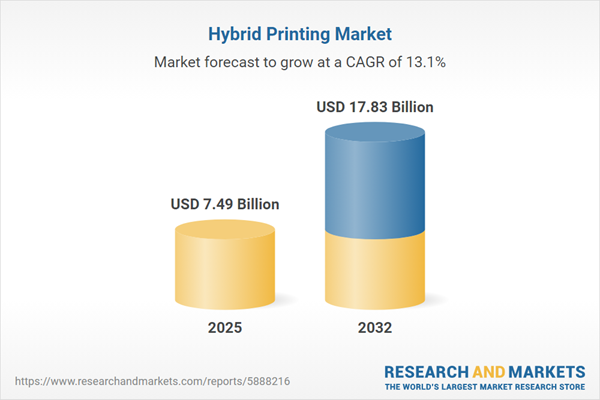Speak directly to the analyst to clarify any post sales queries you may have.
The hybrid printing market is entering a decisive phase, driven by the convergence of digital technologies and traditional analog processes. Senior leaders seeking to upgrade operational agility and sustainability will find that hybrid printing solutions offer new strategies for meeting today’s evolving production requirements.
Market Snapshot: Hybrid Printing Market Size and Growth Potential
The Hybrid Printing Market grew from USD 6.64 billion in 2024 to USD 7.49 billion in 2025. It is expected to continue growing at a CAGR of 13.14%, reaching USD 17.83 billion by 2032.
Market momentum is propelled by mounting demand for personalized and short-run print applications, rapid technological integration, and greater environmental accountability. This expansion underscores hybrid printing’s ability to adapt to industry-specific needs and regulatory developments, providing a pathway to strategic market resilience.
Scope & Segmentation of the Hybrid Printing Market
- Applications: Commercial printing, brochures, business forms, promotional materials, labels (in-mold, self-adhesive, wrap-around), packaging (corrugated boxes, flexible packaging, folding cartons), publishing, books, magazines, and newspapers.
- Technology Types: LED UV hybrid printing, UV hybrid printing, water-based hybrid printing.
- End Users: Commercial printers, label printers, packaging houses, publishers.
- Substrate Options: Films and foils, paper and board, plastics, textiles.
- Ink Types: LED inks, solvent inks, UV inks, water-based inks.
- Regional Coverage:
- Americas (United States, Canada, Mexico, Brazil, Argentina, Chile, Colombia, Peru)
- Europe, Middle East & Africa (United Kingdom, Germany, France, Russia, Italy, Spain, Netherlands, Sweden, Poland, Switzerland, UAE, Saudi Arabia, Qatar, Turkey, Israel, South Africa, Nigeria, Egypt, Kenya)
- Asia-Pacific (China, India, Japan, Australia, South Korea, Indonesia, Thailand, Malaysia, Singapore, Taiwan)
- Key Companies: Heidelberger Druckmaschinen AG, Komori Corporation, Koenig & Bauer AG, Manroland Goss GmbH, Screen Holdings Co., Ltd., HP Inc., Canon Inc., Konica Minolta, Inc., Eastman Kodak Company, Fujifilm Holdings Corporation
Hybrid Printing Market: Key Takeaways
- Hybrid printing integrates precision digital technologies with analog efficiency, enabling tailored print runs while preserving high throughput standards.
- The adoption of LED UV curing systems and water-based platforms enhances sustainability, energy efficiency, and compliance with emerging environmental standards.
- Digital workflow integrations, including Internet of Things connectivity, foster automated scheduling, real-time analytics, and predictive maintenance, driving consistent print quality improvements.
- Collaborative supply chains, especially among equipment, ink, and substrate providers, are facilitating the seamless fit required to address sector-specific print demands.
- On-demand and localized production models are garnering attention as organizations seek responsive solutions that curtail logistics footprints and accelerate time to market.
- Segmentation reveals new opportunities across applications such as customized packaging and smart labels, as well as specialty substrates for retail and industrial sectors.
Tariff Impact: Navigating Shifting Cost Structures and Sourcing
US tariff measures in 2025 are influencing hybrid printing supply chains. Increased duties on core components have prompted a reassessment of sourcing strategies and led to greater emphasis on regional manufacturing. Stakeholders are negotiating cost-sharing agreements to limit budget unpredictability and bolster operational resilience. These shifts highlight the ongoing need for diversified supply chains and agile production capacity.
Research Methodology & Data Sources
This report employs a hybrid research methodology, combining primary insight from industry leaders with secondary analysis of published literature, supply chain mapping, and regulatory data. Rigorous triangulation and scenario modeling help validate all market assumptions and forecast dynamics.
Why This Report Matters
- Empowers decision-makers with actionable intelligence on market drivers, risks, and hybrid printing adoption strategies relevant to complex operational realities.
- Clarifies how technological advancements and sustainability initiatives intersect to shape both short-term tactics and long-term investment choices.
- Facilitates benchmarking by analyzing regional trends, key player strategies, and supply chain dynamics, providing a foundation for competitive differentiation.
Conclusion
Hybrid printing is reshaping the print landscape, providing new capabilities in sustainability, automation, and customized output. Strategic adaptation to evolving technologies and supply chain scenarios will be key to long-term growth and market leadership.
Additional Product Information:
- Purchase of this report includes 1 year online access with quarterly updates.
- This report can be updated on request. Please contact our Customer Experience team using the Ask a Question widget on our website.
Table of Contents
3. Executive Summary
4. Market Overview
7. Cumulative Impact of Artificial Intelligence 2025
Companies Mentioned
The companies profiled in this Hybrid Printing market report include:- Heidelberger Druckmaschinen AG
- Komori Corporation
- Koenig & Bauer AG
- Manroland Goss GmbH
- Screen Holdings Co., Ltd.
- HP Inc.
- Canon Inc.
- Konica Minolta, Inc.
- Eastman Kodak Company
- Fujifilm Holdings Corporation
Table Information
| Report Attribute | Details |
|---|---|
| No. of Pages | 184 |
| Published | October 2025 |
| Forecast Period | 2025 - 2032 |
| Estimated Market Value ( USD | $ 7.49 Billion |
| Forecasted Market Value ( USD | $ 17.83 Billion |
| Compound Annual Growth Rate | 13.1% |
| Regions Covered | Global |
| No. of Companies Mentioned | 11 |









